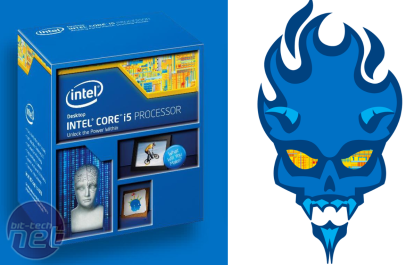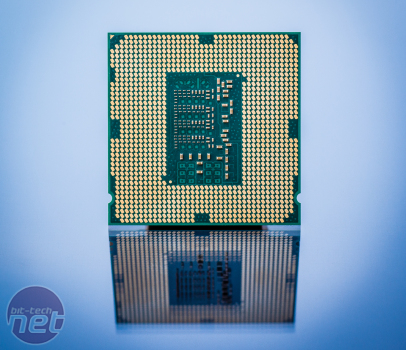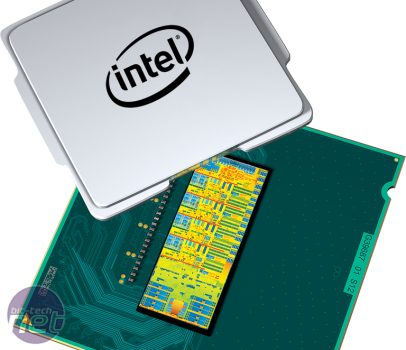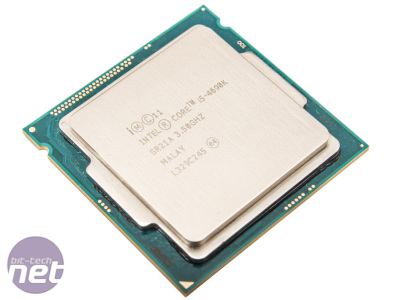
I think it's fair to say that Intel's latest CPUs have been met with a mixture of emotions by enthusiasts. At the crux of the issue is likely the fact that Intel is likely looking at markets away from the PC as tablets and smartphones take a big old slice of PC sales pie, despite the fact that PC sales have been predicted to and now seem to be stabilising.
That's not to say it's pulling out of the PC market - far from it. However, we haven't seen the kind of performance increases in new architectures or refreshes/ticks that we have done in the past. Even after AMD was placed firmly in catchup mode following the release of the first Core architecture, we still saw significant improvements in performance, for example, in the move from LGA775’s Penryn and Wolfdale to Clarkdale and again from Clarkdale/Lynnfield/Nehalem to Sandy Bridge.
There was a huge leap in performance going from a dual core Core 2 CPU to the dual core Core i5-530, which even gave previous generation quad cores such as the Q6600 a run for their money. Only in specific tests do we see anywhere near this level of performance increase in the post-Sandy Bridge era, and even then, the argument for upgrading, even including the LGA1155 to LGA1150 socket change, is only strong if you own a Sandy Bridge system: Ivy Bridge and Haswell owners needn't bother, although the additional features provided by the Z97 chipset may well temp you too.
However, there's another very good reason for upgrading to Devil's Canyon. Overclocking. It seems that as well as providing smoother power delivery and a better thermal interface material (I should add that people are still delidding these CPUs and seeing better cooling though), Intel has been speed-binning CPUs.
In short, the widely varying overclocks we saw with Ivy Bridge and Haswell, which ranged from 4.3GHz to 5GHz, appear to be a thing of the past and the vast majority of new CPUs, the Pentium G3258 Anniversary Edition included, can reach 4.8GHz with relative ease. It's always been a lottery with CPUs and overclocking and retailers have often cherry picked CPUs too and sold them at higher prices for guaranteed overclocks. You'd need a good CPU cooler, and for some reason, 4.8GHz appear to be the limit unless you drastically boost the CPU voltage, but even so, this is 300-400MHz faster than you'd expect from a typical Core i5-4670K retail sample.
To prove our point, as Intel annoyingly didn't ship out a Core i5-4690K to us, we bought our own retail copy and this performed exactly the same as our Core i7-4790K press sample. You only have to look at forum system spec signatures to see just how many people are having to be content with a 4.3GHz or 4.4GHz CPU. In addition, our 4.8GHz test system only drew 20W more at load and the CPU was much cooler than a 4.6GHz Core i5-4670K-based system, so it's quite feasible to have your CPU at 4.7GHz or 4.8GHz 24/7.
This on its own is a very appealing feature - after all, who wouldn't want a speed-binned CPU and in the past, retailers have even charged more for such sought-after silicon (remember G0-stepping Q6600's?) Yet Devil's Canyon CPUs didn't cost much more, if at all than their predecessors. Yes there’s not much if any improvement in IPC and most of the speed boosts at stock speed are due to increased CPU frequencies – the Core i7-4790K for example has a stock speed of 4GHz, which is a substancial 500MHz faster than its predecessor, but that’s the kind of thing you can do with a cherry-picked CPU.
There is, of course, the argument that Intel has shunned the PC and the PC enthusiast by just speed-binning Haswell cores, but if anything, this is showing that it still has a commitment to enthusiasts and in particular overclockers.
Yes I’d like to have seen more of a performance boost or shrunken manufacturing process, although the latter is what we'll be looking at with Broadwell, but I’d rather have a Devil’s Canyon CPU that’s guaranteed to hit 4.8GHz and provide some overclocking fun, than something that performs a few percent faster clock for clock than the previous round of LGA1150 CPUs and once again runs very hot under the collar once you’ve overclocked it along with being lucky to be able to get a stable overclock above 4.4GHz.
This won’t be everyone’s cup of tea of course, but I’m willing to bet that most people reading this, especially those that are potential buyers of the new Core i5 and Core i7, would be overclocking their CPUs too. It probably cost Intel less to tweak the power delivery, use better thermal interface material and speed-bin some CPUs, than it would have done to make similar changes to what we saw moving from Sandy Bridge to Ivy Bridge, but I’m not really that bothered.
However, I do want to see some improvements with Broadwell. With Windows 9 due out at roughly the same time (although rumours are that K-series Broadwell CPUs may have been delayed yet again till next summer) and rumoured to be much more geared toward PC users, they could provide the perfect opportunity for pre-Haswell owners to reach for their wallets.
That's not to say it's pulling out of the PC market - far from it. However, we haven't seen the kind of performance increases in new architectures or refreshes/ticks that we have done in the past. Even after AMD was placed firmly in catchup mode following the release of the first Core architecture, we still saw significant improvements in performance, for example, in the move from LGA775’s Penryn and Wolfdale to Clarkdale and again from Clarkdale/Lynnfield/Nehalem to Sandy Bridge.
Click to enlarge
There was a huge leap in performance going from a dual core Core 2 CPU to the dual core Core i5-530, which even gave previous generation quad cores such as the Q6600 a run for their money. Only in specific tests do we see anywhere near this level of performance increase in the post-Sandy Bridge era, and even then, the argument for upgrading, even including the LGA1155 to LGA1150 socket change, is only strong if you own a Sandy Bridge system: Ivy Bridge and Haswell owners needn't bother, although the additional features provided by the Z97 chipset may well temp you too.
However, there's another very good reason for upgrading to Devil's Canyon. Overclocking. It seems that as well as providing smoother power delivery and a better thermal interface material (I should add that people are still delidding these CPUs and seeing better cooling though), Intel has been speed-binning CPUs.
Click to enlarge
In short, the widely varying overclocks we saw with Ivy Bridge and Haswell, which ranged from 4.3GHz to 5GHz, appear to be a thing of the past and the vast majority of new CPUs, the Pentium G3258 Anniversary Edition included, can reach 4.8GHz with relative ease. It's always been a lottery with CPUs and overclocking and retailers have often cherry picked CPUs too and sold them at higher prices for guaranteed overclocks. You'd need a good CPU cooler, and for some reason, 4.8GHz appear to be the limit unless you drastically boost the CPU voltage, but even so, this is 300-400MHz faster than you'd expect from a typical Core i5-4670K retail sample.
Click to enlarge
To prove our point, as Intel annoyingly didn't ship out a Core i5-4690K to us, we bought our own retail copy and this performed exactly the same as our Core i7-4790K press sample. You only have to look at forum system spec signatures to see just how many people are having to be content with a 4.3GHz or 4.4GHz CPU. In addition, our 4.8GHz test system only drew 20W more at load and the CPU was much cooler than a 4.6GHz Core i5-4670K-based system, so it's quite feasible to have your CPU at 4.7GHz or 4.8GHz 24/7.
This on its own is a very appealing feature - after all, who wouldn't want a speed-binned CPU and in the past, retailers have even charged more for such sought-after silicon (remember G0-stepping Q6600's?) Yet Devil's Canyon CPUs didn't cost much more, if at all than their predecessors. Yes there’s not much if any improvement in IPC and most of the speed boosts at stock speed are due to increased CPU frequencies – the Core i7-4790K for example has a stock speed of 4GHz, which is a substancial 500MHz faster than its predecessor, but that’s the kind of thing you can do with a cherry-picked CPU.
There is, of course, the argument that Intel has shunned the PC and the PC enthusiast by just speed-binning Haswell cores, but if anything, this is showing that it still has a commitment to enthusiasts and in particular overclockers.
Yes I’d like to have seen more of a performance boost or shrunken manufacturing process, although the latter is what we'll be looking at with Broadwell, but I’d rather have a Devil’s Canyon CPU that’s guaranteed to hit 4.8GHz and provide some overclocking fun, than something that performs a few percent faster clock for clock than the previous round of LGA1150 CPUs and once again runs very hot under the collar once you’ve overclocked it along with being lucky to be able to get a stable overclock above 4.4GHz.
Click to enlarge
This won’t be everyone’s cup of tea of course, but I’m willing to bet that most people reading this, especially those that are potential buyers of the new Core i5 and Core i7, would be overclocking their CPUs too. It probably cost Intel less to tweak the power delivery, use better thermal interface material and speed-bin some CPUs, than it would have done to make similar changes to what we saw moving from Sandy Bridge to Ivy Bridge, but I’m not really that bothered.
However, I do want to see some improvements with Broadwell. With Windows 9 due out at roughly the same time (although rumours are that K-series Broadwell CPUs may have been delayed yet again till next summer) and rumoured to be much more geared toward PC users, they could provide the perfect opportunity for pre-Haswell owners to reach for their wallets.

MSI MPG Velox 100R Chassis Review
October 14 2021 | 15:04









Want to comment? Please log in.